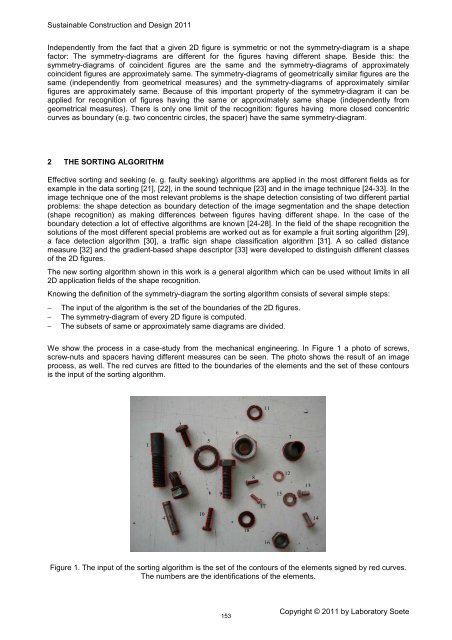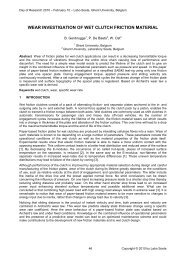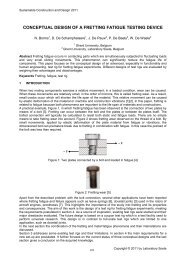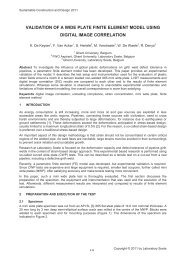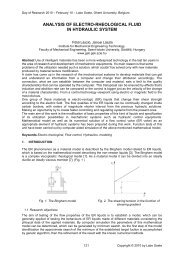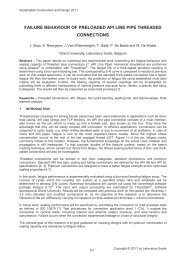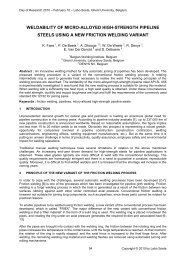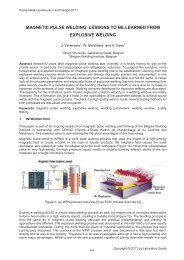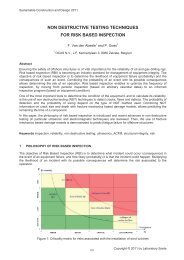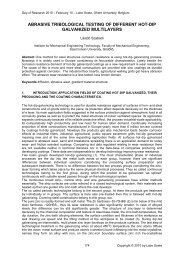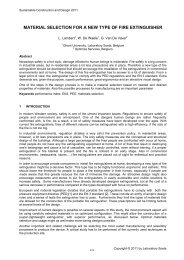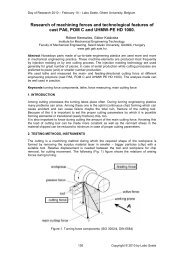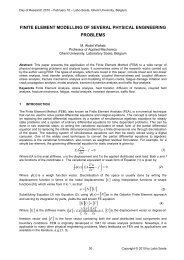Volume 2, Issue 1, 2011, Full Text - 5th International Conference on ...
Volume 2, Issue 1, 2011, Full Text - 5th International Conference on ...
Volume 2, Issue 1, 2011, Full Text - 5th International Conference on ...
You also want an ePaper? Increase the reach of your titles
YUMPU automatically turns print PDFs into web optimized ePapers that Google loves.
Sustainable C<strong>on</strong>structi<strong>on</strong> and Design <str<strong>on</strong>g>2011</str<strong>on</strong>g><br />
Independently from the fact that a given 2D figure is symmetric or not the symmetry-diagram is a shape<br />
factor: The symmetry-diagrams are different for the figures having different shape. Beside this: the<br />
symmetry-diagrams of coincident figures are the same and the symmetry-diagrams of approximately<br />
coincident figures are approximately same. The symmetry-diagrams of geometrically similar figures are the<br />
same (independently from geometrical measures) and the symmetry-diagrams of approximately similar<br />
figures are approximately same. Because of this important property of the symmetry-diagram it can be<br />
applied for recogniti<strong>on</strong> of figures having the same or approximately same shape (independently from<br />
geometrical measures). There is <strong>on</strong>ly <strong>on</strong>e limit of the recogniti<strong>on</strong>: figures having more closed c<strong>on</strong>centric<br />
curves as boundary (e.g. two c<strong>on</strong>centric circles, the spacer) have the same symmetry-diagram.<br />
2 THE SORTING ALGORITHM<br />
Effective sorting and seeking (e. g. faulty seeking) algorithms are applied in the most different fields as for<br />
example in the data sorting [21], [22], in the sound technique [23] and in the image technique [24-33]. In the<br />
image technique <strong>on</strong>e of the most relevant problems is the shape detecti<strong>on</strong> c<strong>on</strong>sisting of two different partial<br />
problems: the shape detecti<strong>on</strong> as boundary detecti<strong>on</strong> of the image segmentati<strong>on</strong> and the shape detecti<strong>on</strong><br />
(shape recogniti<strong>on</strong>) as making differences between figures having different shape. In the case of the<br />
boundary detecti<strong>on</strong> a lot of effective algorithms are known [24-28]. In the field of the shape recogniti<strong>on</strong> the<br />
soluti<strong>on</strong>s of the most different special problems are worked out as for example a fruit sorting algorithm [29],<br />
a face detecti<strong>on</strong> algorithm [30], a traffic sign shape classificati<strong>on</strong> algorithm [31]. A so called distance<br />
measure [32] and the gradient-based shape descriptor [33] were developed to distinguish different classes<br />
of the 2D figures.<br />
The new sorting algorithm shown in this work is a general algorithm which can be used without limits in all<br />
2D applicati<strong>on</strong> fields of the shape recogniti<strong>on</strong>.<br />
Knowing the definiti<strong>on</strong> of the symmetry-diagram the sorting algorithm c<strong>on</strong>sists of several simple steps:<br />
−<br />
−<br />
−<br />
The input of the algorithm is the set of the boundaries of the 2D figures.<br />
The symmetry-diagram of every 2D figure is computed.<br />
The subsets of same or approximately same diagrams are divided.<br />
We show the process in a case-study from the mechanical engineering. In Figure 1 a photo of screws,<br />
screw-nuts and spacers having different measures can be seen. The photo shows the result of an image<br />
process, as well. The red curves are fitted to the boundaries of the elements and the set of these c<strong>on</strong>tours<br />
is the input of the sorting algorithm.<br />
11<br />
1<br />
2<br />
5<br />
6<br />
7<br />
3<br />
9<br />
8<br />
15<br />
12<br />
13<br />
4<br />
10<br />
17<br />
14<br />
18<br />
16<br />
Figure 1. The input of the sorting algorithm is the set of the c<strong>on</strong>tours of the elements signed by red curves.<br />
The numbers are the identificati<strong>on</strong>s of the elements.<br />
153<br />
Copyright © <str<strong>on</strong>g>2011</str<strong>on</strong>g> by Laboratory Soete


